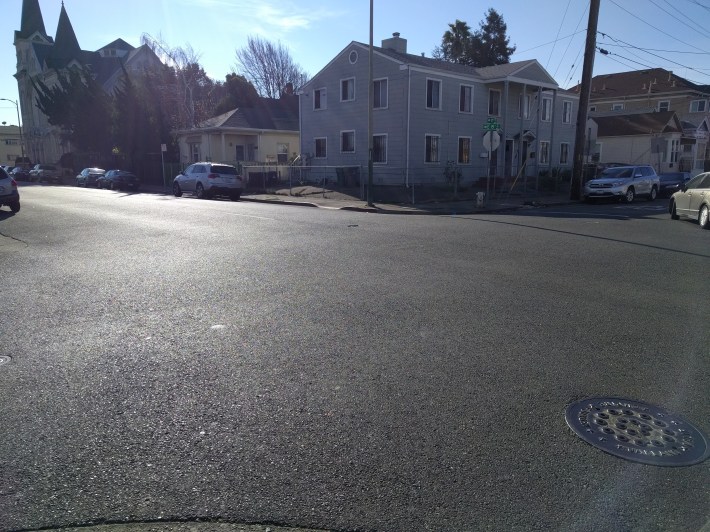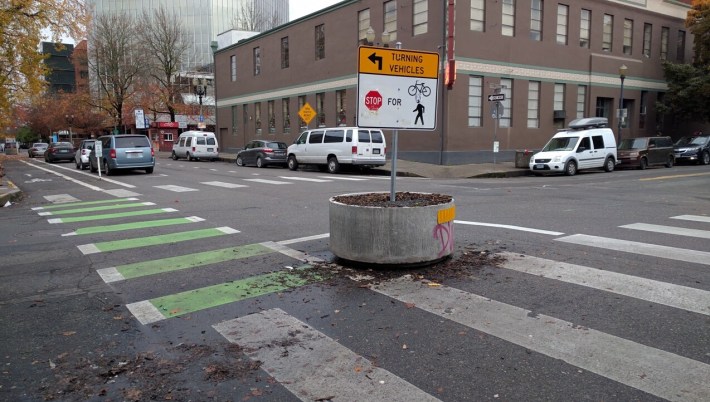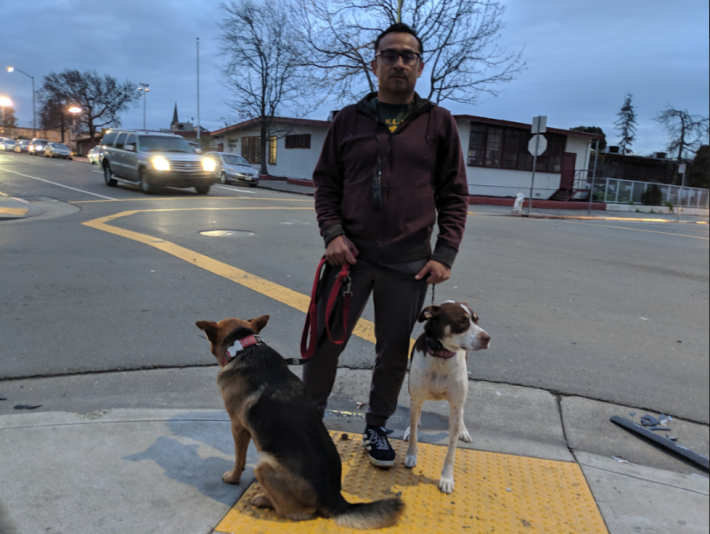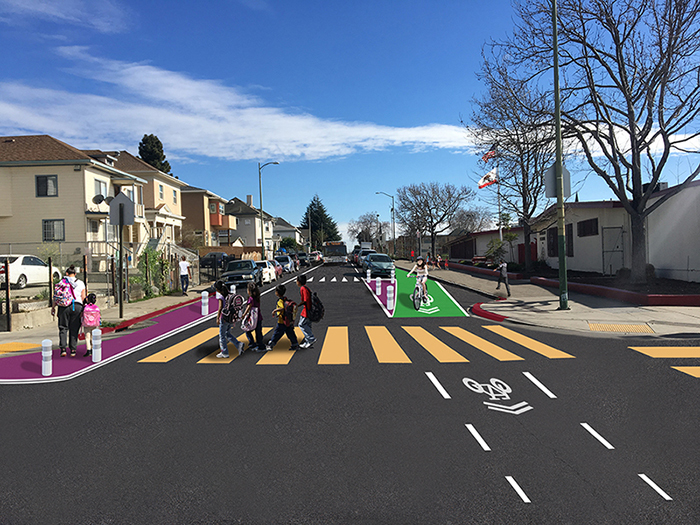Note: GJEL Accident Attorneys regularly sponsors coverage on Streetsblog San Francisco and Streetsblog California. Unless noted in the story, GJEL Accident Attorneys is not consulted for the content or editorial direction of the sponsored content.
A motorist struck a 14-year-old boy last week who was riding his bike on 35th Avenue in Fruitvale, dragged him for four blocks, stopped momentarily, and then drove off. The East Bay Times is reporting that the City of Oakland, given the history of bad crashes on 35th, is prioritizing pedestrian safety improvements on this notorious stretch of street.
Unfortunately, Oakland's young new DOT inherited more than a few dangerous streets and intersections.
Silvio Carrillo, frustrated with a lack of any clear response after calling the city's non-emergency 311 service and reaching out directly to city officials, emailed Streetsblog just before the holidays to try and get safety fixes sped up at another danger zone, around Franklin Elementary school, near his home. "In our neighborhood in Clinton a little less than a mile east/south of Lake Merritt where many immigrants and people of color live, where we have the largest elementary school in the city, where a child was hit by a car last year where we’ve had four accidents in four weeks (at least seven in a year)--Public Works has done nothing," he wrote.
Streetsblog took a tour of the area and, indeed, many crosswalks aren't clearly marked and at many corners around the school, there are no pedestrian markings at all (see image below). Traffic speeds on Foothill and 15th, the two one-way streets that bracket the school, are fast-moving, with very few safety measures. Motorist compliance when pedestrians try to cross at the corners is basically nil. Although there are a few bulbouts and one signalized crosswalk at 10th, overall the situation is totally inadequate for regulating cars passing an elementary school in a residential area.

Carrillo's question for the City of Oakland is simple: why isn't he seeing progress on Foothill? You'd think the city would drop in safe-hit posts, heavy planters, or some kind of temporary barriers almost overnight to make sure little children don't get hit. The only real response he's gotten after sending a bunch of emails was from Joe Wang, Supervising Transportation Engineer with the City of Oakland, who replied on Dec. 22:
Part of our challenge of trying to solve so many safety-related issues, including those around schools, is to be efficient with the management of our resources. With Nicole [Nicole Ferrara, Vision Zero manager] already on the issue and Brytanee [Brytanee Brown, Transportation Planner] designated in her role during her absence, I don’t want to recreate a process that’s already started. I will wait until Nicole returns [she's on maternity leave] to discuss with her how to move things forward.
This lack of urgency among public officials, even when the safety of small children is at stake, frustrates advocates and residents. "After a pedestrian was killed at 23rd/Harrison, OakDOT designed and installed a great traffic safety project in just a few months, so we know they have it in them to respond quickly," wrote Bike East Bay's Education Director, Robert Prinz, in an email to Streetsblog. Prinz said his organization is trying to press Oakland to break away from doing fixes according to a grant and paving schedule, and instead get in there fast in areas where there are known, ongoing, and immediate dangers.
But even the Harrison crosswalk took months. Dave Campbell, Advocacy Director at Bike East Bay, pointed out that when a truck damaged part of the MacArthur Maze a few years back, Oakland and Caltrans workers re-striped local streets to accommodate car traffic the very next day. "And by the way, they removed a bike lane on Grand to accommodate more cars, and asked nobody for permission."
That said, Wang isn't wrong--it is true that the city has a process to fix Foothill (as seen in the lead image), based on designs Ferrara employed at 23rd and Harrison. But that Foothill project was, apparently, approved some time ago. Walk Oakland Bike Oakland president Chris Hwang reached out on behalf of Streetsblog to another Oakland DOT officials to try and get an answer to Carrillo's questions.
And here's a response from OakDOT's Senior Transportation Planner, Sarah Fine:
In December, Council approved a lane conversion on both Foothill and E 15th to reduce to one lane in each direction and add new bike lanes between 1st Ave and 14th Ave. At this time, we anticipate these improvements will be delivered next summer/fall—partially through a preventative maintenance paving job....
We also have progress to report on improvements on Foothill between 14th and 23rd Ave. Crews will be out in the next couple of weeks to perform curb ramp improvements, the precursor to repaving in February. With this repaving, we’re incorporating another lane conversion to support new buffered bike lanes, which is a concept brought forward at least 15 years ago through the 23rd Ave Community Action Plan. We’re looking forward to delivering these improvements to support safe routes to Garfield Elementary, San Antonio Park, and to the other schools and churches in the neighborhood.
That's good news of course, but hardly the fast turnaround Campbell and other advocates want to see.
Without argument, Oakland is making progress at its new Department of Transportation. But it desperately needs an autonomous Rapid Response Team, something akin to what was legislated in San Francisco a couple of years ago (but hopefully even faster), with dedicated crews and equipment. Oakland, under Ferrara, is working on a Vision Zero, fast response effort [Streetsblog has inquiries out about where things currently stand] but it can't come soon enough, and judging by Carrillo's experience, it will require a big cultural shift to be effective.
[UPDATE 1/8, 8:22 a.m., from OakDOT communications "...we do review severe collisions to evaluate whether immediate or short-term fixes can be made quickly. This is a balancing act, because many of the same staff who would perform those swifter fixes are also responsible for long-term safety improvements."]
Unfortunately, remaining "efficient" by staying on a paving schedule, or waiting for grants to clear, doesn't help if people are killed or maimed in the interim. Oakland, and other cities in the Bay Area, need to have a warehouse full of heavy planters, paint, hit posts, Jersey barriers, etc. and general safety treatment plans and teams ready to put them in place every day. Other countries manage to build temporary bike lanes and sidewalks during construction projects that are safer than Foothill, 35th, or many other streets in Oakland. There's no reason Oakland can't respond anywhere a hazardous condition exists with fast, temporary fixes, regardless of when the next paving is scheduled, with the same kind of urgency transportation officials show when a freeway is damaged and there's a need to add emergency car capacity.

"We all want to see a quick response and we know they can do it," said Campbell. "A department that has 100 staffers to work on street improvements; we think this should be a higher priority."
"Our neighborhood has historically not been one to speak up, it is mostly Asian immigrants, black and Latino/Hispanic who put their heads down each day and head off to work without complaining," wrote Carrillo. "...I think Public Works mindset, legacy and leadership have been reactive which has historically been a problem, they need to understand how to be proactive in areas that have historically been ignored to truly be transformational."






